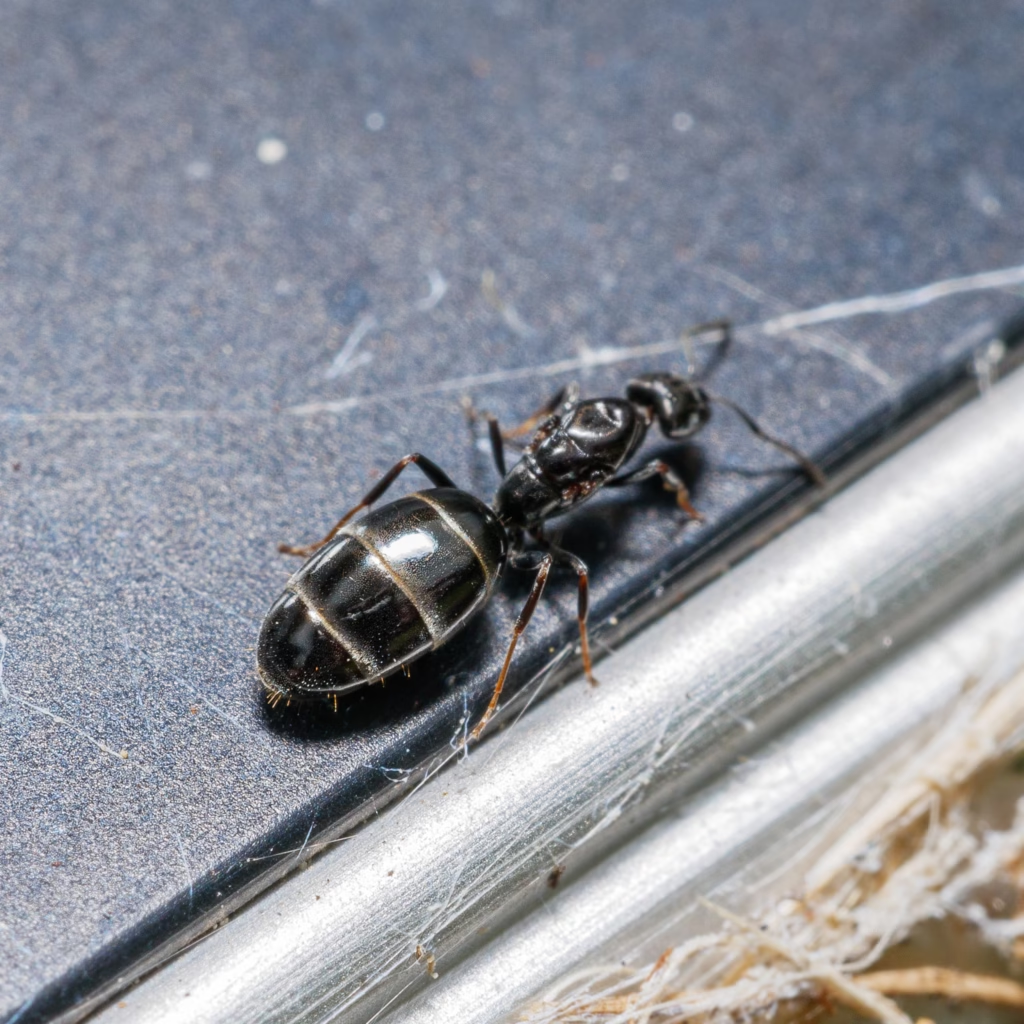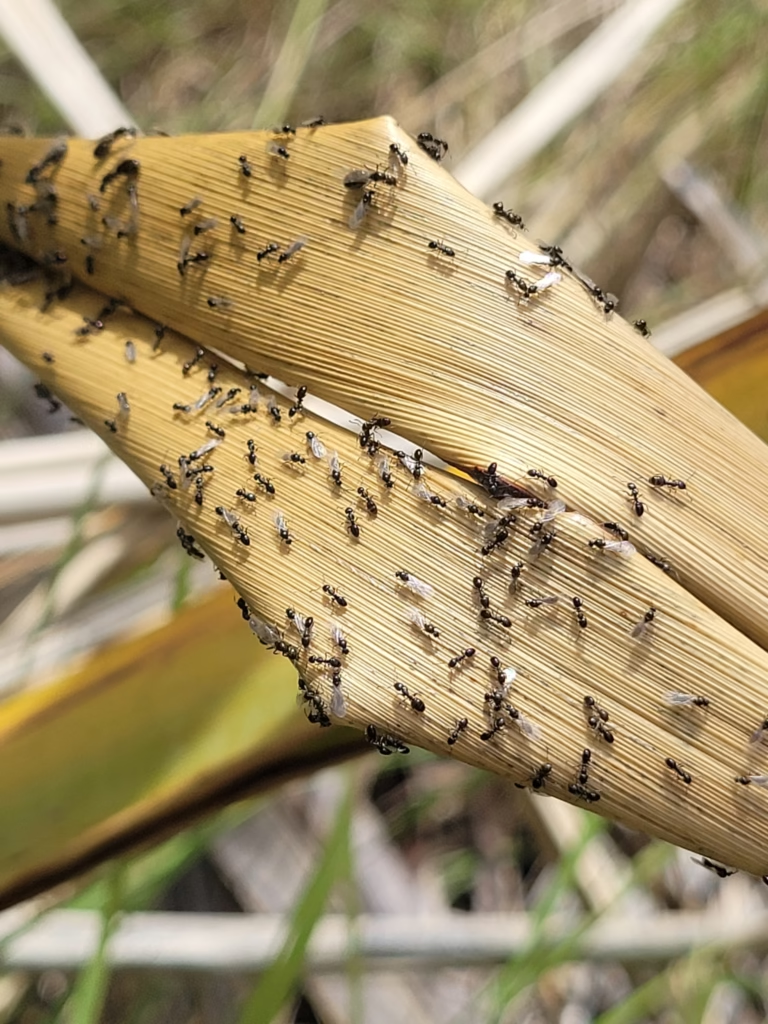| Scientific Name | Ochetellus glaber |
|---|---|
| Common Name | Black Household Ant |
| Size | Workers: 2.5–3.5 mm | Queens: 6–7 mm |
| Lifespan | Queens ~5 years | Workers ~6–12 months |
| Colony Type | Polygynous (Multiple Queens) |
| Foraging Activity | Diurnal & Nocturnal |
| Natural Habitat | Urban areas, forests, and grasslands across Australia |
| Nuptial Flight Season | Spring to early summer (Oct–Dec) |
| Hibernation | None – remains active year-round |
| Founding Type | Semi-claustral – Queen requires occasional feeding |
1. Introduction to Black Household Ants
Black Household Ant care is rewarding but challenging, as this species is one of Australia’s most adaptable natives. The Black Household Ant (Ochetellus glaber) thrives in both natural and urban environments. You’ll often spot them inside homes, scavenging for sugary treats and crumbs — a familiar (and sometimes frustrating) guest at Aussie barbecues.
What makes them especially fascinating for ant keepers is their polygynous nature. Multiple queens can coexist in the same colony, leading to rapid expansion and relentless foraging activity. Colonies can grow to tens of thousands of workers, so while they’re fun and active, they’re also best suited for keepers ready to handle larger populations.
⚠️ Warning: If you’ve ever left a coke can outside, you’ve probably met these ants up close!
2. Natural Habitat and Distribution
Black Household Ants are native to Australia and thrive in a wide variety of environments:
- Cities & Suburbs – Nesting in walls, kitchens, and gardens
- Forests & Woodlands – Under bark, inside logs, and soil
- Grasslands & Open Fields – Common in sandy, well-drained soil
Nesting Preferences:
Highly adaptable – Will relocate nests when needed
Opportunistic nesters – Can live in soil, trees, and buildings
Polygynous colonies – Multiple queens = rapid growth
🔗 Related Guide: How to Find Queen Ants in Australia
3. Nuptial Flights – When and Where to Catch a Queen
Catching an Ochetellus glaber queen requires good timing, patience, and sometimes a strategically placed sugary snack. Queens are much harder to come across than workers, which makes finding one a real prize for keepers.
When Do Black Household Ants Have Nuptial Flights?
- Peak Season: Spring to early summer (October–December)
- Weather Conditions: Warm, humid days, often after rain
- Time of Day: Afternoon to early evening (3 PM – 8 PM)
How to Identify a Queen Black Household Ant:
- Larger size – ~6–7 mm, bulkier than workers
- Glossy black exoskeleton – same colour as workers but with a thicker thorax
- Solitary behaviour – newly mated queens roam alone, searching for a nesting site
🔗 Related Guide: What to Do with a Queen Ant After Capture
📖 External Resource: For scientific details on Ochetellus glaber, see the AntWiki species profile.

4. Founding Stage – Test Tube Setup
Unlike fully claustral queens, Ochetellus glaber queens require occasional feeding during the founding stage.
Test Tube Setup for a Black Household Ant Queen
- Test tube size: 16–20 mm diameter, glass or plastic
- Water reservoir: One-third full, sealed with cotton
- Cotton plug: Allows airflow while preventing escapes
- Feeding needs: Offer tiny drops of honey water every few days
- Storage conditions: Keep dark and undisturbed at 24–28 °C
When to Move to a Nest
- Wait until the colony has 20+ workers before transferring to a formicarium
🔗 Related Guide: The Perfect Test Tube Setup for Queen Ants
5. Black Household Ant Care – Housing & Nesting
Secure setups are essential for long-term Black Household Ant care, especially since colonies can grow to tens of thousands. Without proper barriers, they will find their way out — guaranteed.
Best Nest Types for Black Household Ants:
- Acrylic nests – Great visibility, easy maintenance
- 3D-printed nests – Customisable and expandable
- Ytong (aerated concrete) nests – Retains moisture well
- Naturalistic setups – Allows soil digging, mimicking wild behaviour
🚨 Warning: Ochetellus glaber climbs smooth surfaces with ease, so PTFE barriers or tight-fitting lids are crucial!
🔗 Related Guide: Moving Your Queen Ant to a Formicarium
Black Household Ant Care – Feeding & Diet
These ants love sugar but also require protein for brood development.
Best Foods for Black Household Ants:
- Proteins (for larvae & queens): Mealworms, crickets, small insects
- Sugars (for worker energy): Honey water, sugar water, soft fruits
- Bonus treat: They readily drink syrupy liquids, so don’t leave soda cans unattended!
Feeding Frequency:
- Feed every 2–3 days
- Remove leftovers to prevent mould
🔗 Related Guide: The Ultimate Ant Feeding Guide
7. Seasonal Dormancy & Hibernation
Unlike many ants, Ochetellus glaber remains active all year.
- Dormancy period: None – active year-round
- Winter temperature: Can tolerate cooler temps (18–20 °C)
- Feeding adjustments: Reduce feeding slightly, but always provide fresh water
8. Common Problems & Troubleshooting
Problem: Queen Isn’t Laying Eggs
🚨 Possible Causes:
- Too much disturbance – Check only once every 1–2 weeks
- Temperature too low – Keep at 24–28 °C
- Queen is infertile – If she lays only male eggs, she didn’t mate properly
🔗 Related Guide: How to Keep Your Ants Safe from Mites and Pests
Final Thoughts
With the right setup, Black Household Ant care can be rewarding for keepers who enjoy fast-paced colonies.
Watching these ants scout, recruit, and swarm food sources is fascinating — but beware: if there’s a tiny gap in your setup, they WILL find it.
✅ Great for intermediate to advanced keepers
❌ Escape-prone – requires secure setups
🐜 Would you keep Black Household Ants? Let us know in the comments!

